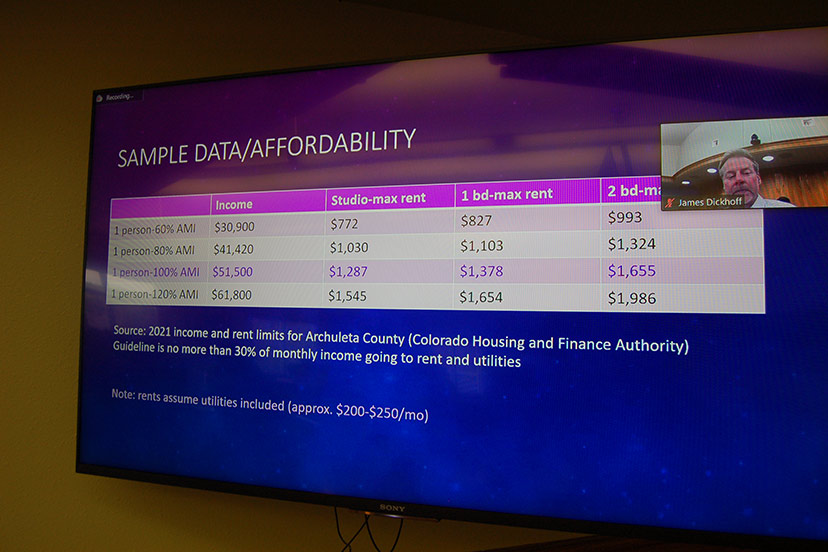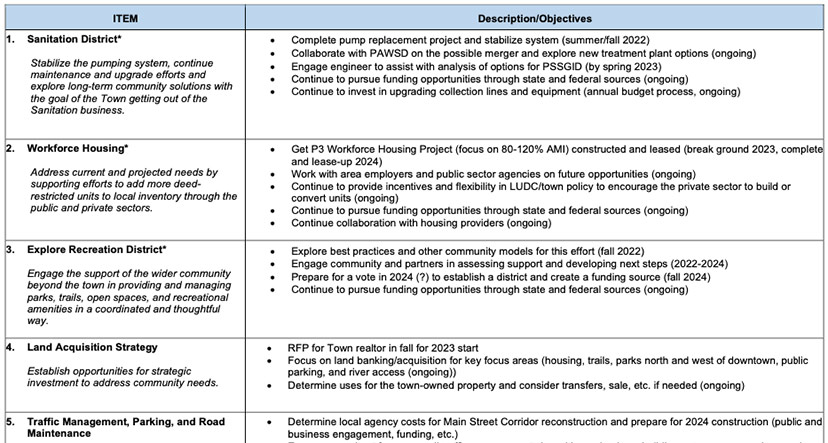The Town staff had concerns on November 1, about the numbers shown in the Servitas pro forma. Mayor Shari Pierce also had concerns, especially about the many working individuals and families who would find the rental rates in this 98-unit project unaffordable.
“Just knowing what families are making here, and how expensive it is to live here,” the Mayor explained, “I think we’re going to have to consider some other factors. Other than what you’re showing us…”
The Town’s independent financial consultant, Steve Clark, also had concerns about the projections shared by Servitas vice president Garrett Scharton. Mr. Clark specifically questioned the 2% vacancy rates built into the Servitas pro forma.
Any rental property will find itself vacant at times. How often? And for how long?
If the Town of Pagosa Springs and Servitas were to build 98 rental units, priced between $1,151 per month and $2,775 per month, what vacancy rate might the project experience over, say, the next three decades? Because the loan for the project — amounting to $75 million in payments over 34 years — is going to be paid either by rental income, or by the taxpayers.
Vacant units don’t pay rent. Hence, the concern.
Consultant Clark suggested that the estimate used by Servitas to justify its project — 2% — is probably unreasonably low, and that a more reasonable rate would be 5%, or 7%.
In recent years, the rental vacancy rate for Colorado, statewide, has varied between 9.35% (the peak in 2005) and 5.0% (in November 2022).
Why would an experienced housing developer like Servitas use a (possibly unreasonable) vacancy rate like 2%?
Because all their previous projects have been student housing for universities, perhaps?

On Mr. Clark’s recommendation, the Town Council directed Mr. Scharton to bring back a new pro forma, showing a cash flow model based on 5% and 7% vacancy rates. This seems like a reasonable request. According to my pocket calculator, the rent shortfall caused by a 5% vacancy rate would be about $129,000 in Year 3, rather than the $51,000 shown in the pro forma shared on November 1. The shortfall would increase with each passing year, if the rate stayed the same.
At 7%, the vacancy-caused rent shortfall would be about $180,000 in Year 3. This is more than the projected financial margin of $104,000 shown for Year 3 in the pro forma.
Would that mean the profits accrued by Servitas would be less? Apparently not. Servitas seems to have designed the project so that all financial risk rests on the Town government. In the event of an economic downturn — or in the event that Servitas designed a money-losing project — the taxpayer subsidy for the project would increase.
Just to be clear, I am not opposed to taxpayer subsidies for housing. Quite the contrary. I’ve spent the past several years encouraging our local governments to develop one or more funding streams that can support workforce housing. Earlier this year, my colleagues and I circulated a petition within the town limits, to establish a new fee on Short-Term Rentals — STRs, vacation rentals — of $150 per bedroom per month, for units located within the town. The revenues would be used to subsidize workforce housing projects aimed at working individuals and families earning 80% or less of the Area Median Income (AMI). That would be an individual earning less than about $46,000 per year, or a family of four bringing in less than about $66,000 per year. You can view the Colorado income levels for various counties, here.
The town voters approved that new fee last April, but a group of STR owners are challenging it in court.
All of the rental units proposed by Servitas, meanwhile, appear to be aimed at households earning 80% or more of the AMI. I find that situation infuriating. According to the Servitas pro forma presented last week, 75% of their one-bedroom units would be affordable only to households that earn $66,000 or more per year, according to Colorado Housing and Finance Administration. 75% of the two-bedroom units would require a household income of at least $73,000.
Basically, the taxpayers — all of us taxpayers — would be subsidizing housing units for the wealthiest half of the population.
Does anyone else besides me think that’s crazy? I mean, I know the rich always get richer, but do we need Pagosa’s least wealthy residents to help subsidize housing options for the rich?
Maybe things are not as bad as they look, however. Maybe there’s a way to salvage this project.
The Town’s Community Development Director, James Dickhoff noted — at the November 1 meeting — that the state of Colorado has a couple of grant programs for housing; one is valued at a maximum of $3 million, and the other at $10 million. The Pagosa Springs community has been successful at winning a number of competitive government grants in recent years.
$10 million in state subsidies — or even $13 million? — might bring the rents, on some of the proposed Servitas units, down to a price that real working people can actually afford.
At last night’s November 17 Town Council meeting, the proposed 2023 Town budget was discussed. The lengthy agenda packet included not only the proposed budget, but also a ten-year Capital Improvement Plan indicating the projects the Town was contemplating over the next decade.
Also included in the packet were the Council’s “Goals” for the coming year. First on the list is stabilization of the Town’s sewer pumping system, and collaboration with PAWSD (Pagosa Area Water and Sanitation District) to explore the possibility of a merger “with the goal of the Town getting out of the Sanitation business.”.
The second most important goal — “Workforce Housing” — mentions the hope of breaking ground on the Servitas project next year, and completing it in 2024. But at the moment, the project seems to be “on hold”.
At the end of the meeting last night, Council member Brooks Lindner asked:
“Do we know when we’re going to resume the discussion around Servitas?”
Mayor Pierce responded.
“[Town Manager Andrea Phillips] has asked for more information based on our comments [at the November 1 meeting] — vacancy rates and things like that. We’re waiting to hear back on that.
“And then, we had talked about — at some point — we need to let Servitas know what those rental rates are, that we want to hit. We had a discussion about that as well.”
I admit to being confused by these comments. Servitas was chosen a year ago, by a committee made up of Council members and Town staff, to design and build workforce housing.
A year later, we don’t yet know what rental rates the Town Council wants to hit?



